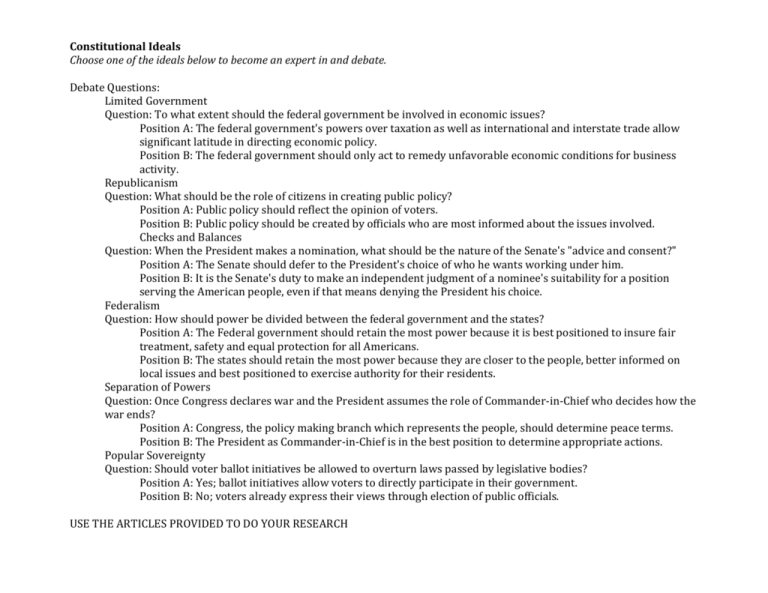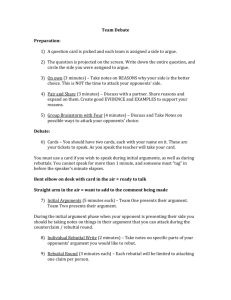File
advertisement

Constitutional Ideals Choose one of the ideals below to become an expert in and debate. Debate Questions: Limited Government Question: To what extent should the federal government be involved in economic issues? Position A: The federal government's powers over taxation as well as international and interstate trade allow significant latitude in directing economic policy. Position B: The federal government should only act to remedy unfavorable economic conditions for business activity. Republicanism Question: What should be the role of citizens in creating public policy? Position A: Public policy should reflect the opinion of voters. Position B: Public policy should be created by officials who are most informed about the issues involved. Checks and Balances Question: When the President makes a nomination, what should be the nature of the Senate's "advice and consent?" Position A: The Senate should defer to the President's choice of who he wants working under him. Position B: It is the Senate's duty to make an independent judgment of a nominee's suitability for a position serving the American people, even if that means denying the President his choice. Federalism Question: How should power be divided between the federal government and the states? Position A: The Federal government should retain the most power because it is best positioned to insure fair treatment, safety and equal protection for all Americans. Position B: The states should retain the most power because they are closer to the people, better informed on local issues and best positioned to exercise authority for their residents. Separation of Powers Question: Once Congress declares war and the President assumes the role of Commander-in-Chief who decides how the war ends? Position A: Congress, the policy making branch which represents the people, should determine peace terms. Position B: The President as Commander-in-Chief is in the best position to determine appropriate actions. Popular Sovereignty Question: Should voter ballot initiatives be allowed to overturn laws passed by legislative bodies? Position A: Yes; ballot initiatives allow voters to directly participate in their government. Position B: No; voters already express their views through election of public officials. USE THE ARTICLES PROVIDED TO DO YOUR RESEARCH Establish Your Argument Debate Question Put the question in your own words. What is the position you are arguing? (in your own words) What is the position your opponent is arguing? (in your own words) Position Argument 1 Argument 2 Argument 3 Argument 4 Argument 5 A B Constitutional Ideals Arguments Limited Government To what extent should the federal government be involved in economic issues? Republicanism What should be the role of citizens in creating public policy? Checks and Balances What should be the nature of the Senate’s “advice and consent”? Federalism How should power be divided between the federal government and the states? Separation of Powers Should the Senate or the President decide how war ends? Popular Sovereignty Should ballot initiatives be allowed to overturn laws passed by the legislative branch? Best Argument Next Best Argument Next Best Argument Next Best Argument Next Best Argument Next Best Argument Debate Format Each debate will last for 15 minutes. Students will be graded on the organization of their own points as well as their participation in the rebuttals. Opening The debate mediator will read the debate question and explain the two sides. Position A will say (not read) their opening argument. Position B will say (not read) their opening argument. The A team will have a chance to rebuttal. The B team will have a chance to rebuttal. Round 1 Position A will share an argument not addressed by their team in the rebuttal. The B team will have a chance to rebuttal. Position B will share an argument not addressed by the teams in rebuttal. The A team will have a chance to rebuttal. Closing Arguments Position A will share any final points. Position B will share any final points. Opinion Students will share their actual opinion on the issue. Students will complete the opinion page of this packet. Rubric Categories Ideas Research Questions Opening Argument Knowledge Significance Supporting Evidence Diction Packet Opinion Participation TOTAL Possible Points (100) 10 Points Student presents three or more accurate and persuasive point and considers counter arguments and perspectives. Student writing is outlined to logically answer all aspects the research question, and provides evidence to persuade audience. Students opening argument is their most powerful argument and is articulated clearly and concisely. Student demonstrates depth of understanding by using real world examples or hypotheticals in their explanation of their points. Student articulates the significance of this issue and their perspective and explains how it contrasts with the opposite perspective. Student has at least four other distinct points to back up their opening argument. Student explains their argument clearly and concisely by choosing their words carefully, applying relevant vocabulary, and staying to the point. Student thoroughly completed the “Constitutional Ideals Arguments” page of this packet. Their responses are accurate. Student thoroughly completed the “Opinion of Ideals” page of this packet, demonstrating depth of consideration. Student participated in team discussions before the debate and spoke up at least once during the debate to support the team’s argument. Earned 8 Points Student presents two or more accurate and persuasive points related to their perspective. Student answers the research question and provides some evidence. 5 Points Student has one persuasive argument. 3 Points Student ideas are inaccurate or lack depth of understanding. Student writing answers the research question but does not logically outline the response. Student does not directly answer the research question. Students opening argument is their most powerful argument. Students opening argument is relatively strong but not their strongest point. Student makes an attempt to use real world examples of their arguments. Student puts the arguments into their own words, but lacks deeper understanding of the implications. Student seems to understand the significance of this issue. Students opening argument is unclear or student seems to lack understanding of the main point. Student doesn’t seem to fully comprehend their arguments. Student articulates the significance of this issue and their perspective. Student doesn’t seem to understand the significance of this issue. Student has more than three distinct points to back up their opening argument. Student thoroughly explained their arguments but they were not clear or concise. Student completed the “Constitutional Ideals Arguments” page of this packet. Student filled in all the squares on the page. Student has a few points but they are mostly repetitive. Student has one main point. Student explains their arguments in their own words. Student arguments are not clearly presented. Student partially filled in the “Constitutional Ideals Arguments” page of this packet. Student partially filled in the squares on the page. Student filled in less than half of the page. Student contributed to the group effort. Student somewhat contributed to the group effort. Student spoke up but their contributions did not move the conversation forward. Student filled in less than half of the squares. Opinion of Ideals Limited Government To what extent should the federal government be involved in economic issues? Republicanism What should be the role of citizens in creating public policy? Checks and Balances What should be the nature of the Senate’s “advice and consent”? Federalism How should power be divided between the federal government and the states? Separation of Powers Should the Senate or the President decide how war ends? Popular Sovereignty Should ballot initiatives be allowed to overturn laws passed by the legislative branch? Position A Position B Your Opinion—Why?





